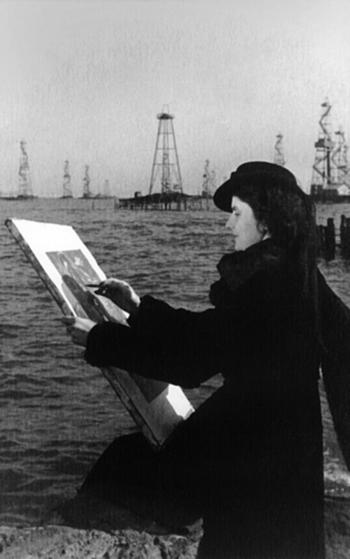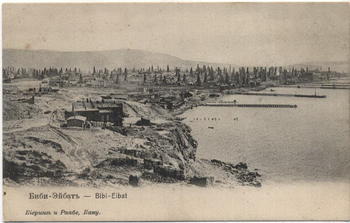Contemporary discussions about Eurasia as a geographical, cultural, economic and political sphere bring aspects of interrelations between regions, nations and empires in the former Soviet empire to the academic fore. Baku, Azerbaijan's capital, serves as one of the Soviet and post-Soviet prime examples to study the implications of such intercultural
exchanges.
Our workshop on 15th July aims to historicize and differentiate Baku’s role as a contact ‘center on the edge’ by bringing examples of Russian-Azeri, Russian-Persian, Azeri-Persian and German-Azeri cultural relations together. Putting these case studies in relation to formative paradigms like multinational Soviet literature, cultural translation, national self-assertion or world literature, the discussion aims to elaborate and identify long-ranging continuities in self-conceptualization and imaginations of the city.
Place: HU Berlin, Unter den Linden 6, Raum 2249A
No registration needed
Programme:
10:00 WELCOME ADDRESS: Torben Philipp (HU Berlin) & Clemens Günther (FU Berlin)
10:30 LEAH FELDMAN (Chicago): „On the Threshold of Eurasia“: Intertextual Encounters in the Caucasus
11:15 Coffee Break
11:30 ANAR IMANOV (Berlin): Geopoetics of Baku in Contemporary Russian Literature
12:15 TORBEN PHILIPP & CLEMENS GÜNTHER: Imaginations of Neft Daşları in Soviet Culture
13:00 Lunch break
14:30 VALENTINA SMIRNOVA (Berlin): Between Modernity and Backwardness:
Baku‘s Urban Space in Azerbaijani Films of the 1920s and 30s 15:15
IBRAHIM IBRAHIMOV (Rouen): Cinema, Identity, Religion: Azerbaijani Cinema as a Zone of Cooperation and Conflict in Elaboration of Religious Component of National Identity (1916-1956)
16:00 Coffee Break
16:30 Aesthetics of the Absurd: Filmscreening: „All for the Best“ by Vagif Mustafayev (1997)
17:15 ELMIR MIRZOEV (Berlin): Baku as a Macabre Space: İçərişəhər (Old city), Oilfields and Salt Lakes
18:00 GÜNAY RZAYEVA (Berlin): M. F. Achundov. Canonization of the writer in the toponymy of Baku in the late Soviet and post-Soviet period
Abstracts:
Leah Feldman (University of Chicago)
On the Threshold of Eurasia: Intertextual Encounters in the Caucasus
Building on her recent book, On the Threshold of Eurasia (2018), this paper frames intertextual encounters as spaces in which a lost archive of inter-cultural contact in the revolutionary Caucasus can be recovered. This paper offers an account of the ways in which fluid social spaces that flourished between writers and thinkers in the Caucasus before the consolidation of nationalities under Soviet rule resonated in literature and theater. The space of the border and the threshold emerges as sites through which alternative forms of belonging can be rendered visible from within the intertwining power structures of empire and nationalism.
Valentina Smirnova (HU Berlin)
Between Modernity and Backwadness: Baku‘s urban space in Azerbaijani films of the 1920s and 30s
The city played an important symbolic role in the rapidly developing cinema of the 1920s. Urban sites on screen simultaneously become markers of modernity and progress. New York, Paris, Moscow and Berlin attract the views of the audience, while concurrently frightening and tempting. From the second half of the 19th century, when the development of the Absheron oil fields began, Baku rapidly became one of the largest industrial and economic centers of tsarist Russia, in which, by 1910, the population growth became comparable to the population growth of the world’s major metropolises. The talk examines how in this context the representation of Baku’s urban space was framed by Bolshevik ideologies during the 1920-30s.
Ibrahim Ibrahimov (Normandie Université)
Cinema, Identity, Religion: Azerbaijani cinema as a zone of cooperation and conflict in elaboration of religious component of national identity (1916-1956)
At the beginning of the 20th century, the emergence of cinema in Azerbaijan coincides with the construction of national identity allowing the cinema to play an important role in this procedure. One of the elements of national identity - the religious component - becomes a controversial topic between local and guest artists (gastrolyor) transforming the cinema at once to the zone of cooperation and conflict.
Torben Philipp (HU Berlin); Clemens Günther (FU Berlin)
Breaking the Waves/The Oil is not enough. Neft Daşları in Visual Culture
In 1949, the Soviet government fired the starting pistol for the construction of the first offshore platforms in the world, Neft Daşları (Oily Rocks). It is located around 100km westwards from Baku and is up to now the world’s only offshore platform organized as an urban settlement with streets, apartment towers and recreational facilities. The unique venue was a landmark project of late Stalinism and inspired Soviet artists from the very beginning. Our talk traces their imaginations from late Stalinism to the Thaw and puts an emphasis on the visual aesthetics of its depiction in architecture, film, literature and fine arts. Drawing predominantly on the feature film Ogni Baku (The Fire of Baku 1950), documentary films by Roman Karmen and the paintings of the so-called surovyj stil (austere, tough style), we focus our analysis on the anthropology and topology of Neft Daşları. We contextualize our findings with earlier Stalinist petropoetics and close by a short view on the anthropology and topology of Neft Daşları. We contextualize our findings with earlier Stalinist petropoetics and close by a short view on the post-Soviet afterlife of the drilling platform, brought to the global fore in James Bond’s The World is not enough (1999).
Elmir Mirzoev (Baku/Berlin)
Baku as a Macabre Space: İçərişəhər (Old city), oilfields and salt lakes
Aesthetics of the absurd: "All for the best" by Vagif Mustafayev
Короткометражный черно-белый фильм "All for the best" (1997, 36 мин.) режиссера Вагифа Мустафаева в снят в контексте одного из самых страшных этнических конфликтов - Нагорно-Карабахском - на постсоветском пространстве. Сюжет фильма, жанр которого условно можно отнести к трагикомедии, построен вокруг спора двух семей из-за цинкового гроба с трупом (погибшего в Карабахе солдата). Оборачивается он неожиданным поворотом, когда при раскрытии гроба обнаруживается, что лежит там вовсе не азербайджанец, а армянин - бывший житель Баку.
Иронический сюрреализм кинематографа Мустафаева, где убийственный сарказм выступает как основная составляющая эстетики абсурда, обыгрывает многие символы советского времени с обратной, "инверсионной" оптики, в котором безусловно угадывается влияние Л.Бюнуэля, а также итальянского неореализма. Картина целиком снята в г. Баку, ландшафты которого (Ичери-шехер, нефтяные промыслы и солёные озера) явственно передают зловещую атмосферу неосязаемой войны - абсолютного человеческого безумия под грохотом громового смеха судьбы, переданного монологом беженца из Армении, ныне жителя Баку, с указкой на цинковый гроб: «Я жил там (в Армении), а он жил здесь (в Баку). Теперь я здесь (в Баку), а он - указывая пальцем на небеса – там!»
Zeit & Ort
15.07.2019 | 10:00
HU Berlin
Unter den Linden 6
Raum 2249A


